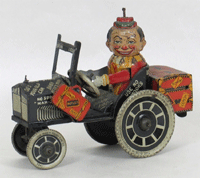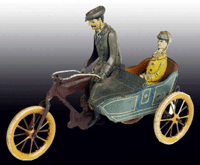When Was
-
The Tin Toy Created?
By Mike McLeod
Posted
June
2007
|
 |
Most toy historians and collectors usually date tin toys to the advent of the
Industrial Revolution in the early 1800s. However, discoveries along the banks
of the Thames River in London a few years ago push that date back to sometime
during the Middle Ages. The Mudlarks, a society of metal detectors who are
legally authorized to search along the Thames, began finding small metal toys
dating to as early as the 1200s. Most of these toys were made of pewter, but an
ornate miniature chair made of tin was discovered. The chair actually resembled
a low cabinet or dresser with two mesh doors on the lower front and arching rods
or poles on the back corners. For a toy, it was highly intricate and of delicate
workmanship for tin.
As a side note, the variety of toys found were in the
shapes of miniature cannon, guns, jugs, frying pans (with metal fish in them),
figures, stools and household items. They now reside in the Museum of London.
This discovery has cast doubt on a popular historical belief. Until recently,
many historians believed that kids during the Middle Ages in Europe had no
childhood and that parents had little affection for their children because
families were large, and many kids died young because of hunger, malnutrition
and disease. In addition, children were often put to work as early as six years
old. For these reasons, it was believed kids rarely played.
This discovery
seems to prove that the learned folk were somewhat mistaken.
It is true that
tin toys were first mass produced during the Industrial Revolution when machines
for stamping out tin patterns were invented. Germany led the way with companies
like Marklin in 1859, Bing in 1863, Fleischman in 1887, Lehmann in 1881 and
Gunthermann in 1880 creating penny playthings for kids. More companies jumped on
board in the early 1900s until the beginning of World War I, which almost
completely halted German production. Other countries like the United States,
Japan and England entered the market on a grand scale at this time. At one
point, the U.S. had up to 50 manufacturers creating tin toys.
Germany
rebounded after WWI, only to be knocked down again by WWII. Both Germany and
Japan came back into production after WWII and imprinted toys with "Made in US
Zone" and "Occupied Japan" (respectively) through the 1950s.
Until about
1875, tin toys were hand painted, if they were painted at all. Then with the
invention of the color printing process of lithography, mass produced toys were
also mass painted. This printing process can be a helpful key in dating tin
toys. Prior to the 1960s, the lithographic process printed each of the four
colors one plate at a time. This yielded an irregular dot print pattern. After
1960, the newer process created a regular dot pattern.
Today, older tin toys
are a favorite collectible. On eBay recently, Morphy Auctions sold a 1908 tin
windup M&K (Muller & Kadeder of Nuremburg, Germany) motorcycle with
sidecar and a woman passenger for $6,000. Of course, most tin toys sell for less
than a hundred dollars, but the older German toys can be pricey.
Popular
designs include boats, cartoon characters, cars, animals, Disney, and the
circus, but even Star Wars has gotten into the act. Osaka Tin Toy Institute
created several limited edition characters in tin (R2-D2, C3PO, Darth Vader,
Boba Fett, and a storm trooper) in 1997 to celebrate the 20th anniversary of the
original movie. The company is now out of business, so these pieces are much
sought after.
But don't confuse those tin figures with the set Hasbro is
currently selling of Star Wars Episode IV figures (Darth Vader, Princess Leia,
C3PO and a storm trooper) for $32.99.
Tin toys are marvels and marvelous, and
from the beginning (whether in the 1200s or the 1800s), kids loved them. Today,
they've lost a little of their shine, but at least adults still love and
appreciate them.
|

1929 Louis Marx Joy Rider wind-up, 8 in. long, $140.
Wording on car says:
''O-Ma the dent maker," "Gimme room," "Vacuum Lizzie," etc. (Photo, courtesy
www.artfact.com.)

This 1908 M&K motorcycle
and sidecar was sold for $6,000 on eBay by
Morphy Auctions. (Photo, courtesy Morphy Auctions.)
|